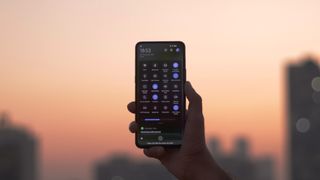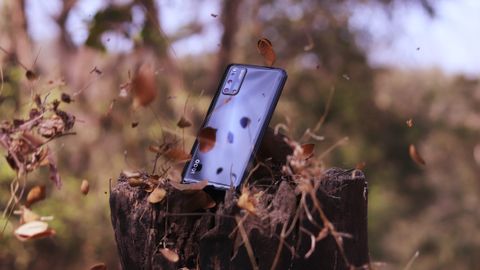Why you can trust TechRadar
Performance

New year, new flagships, new chipset.
The iQoo 3 5G is powered by the latest Snapdragon 865 SoC, making it one of the first phones in India to do so. That is paired with 12GB of LPDDR5 RAM and 256GB of UFS 3.0 storage. Moreover, the Snapdragon X55 modem handles the cellular duties, making this phone 5G-capable.
As expected, the performance is top-notch with no app stuttering to open or keep up. Memory management was equally well, with apps staying where they were left for hours after opening them. It's challenging to slow the iQoo 3 down.
The faster storage does show its usefulness in scenarios such as scrolling through thousands of pictures or large files. You'll know what we're talking about if you've tried sending data to someone via WhatsApp and had to scavenge through thousands of pics.
Gaming

The iQoo 3 5G has a lot of additional hardware and software elements to justify its 'gaming smartphone' tag. As mentioned earlier, there are capacitive shoulder buttons on the right side, meant to be used by index fingers while gaming. Sadly, these buttons are not optimally placed where the tips of your fingers will rest, thus forcing us to have an awkwardly supinated wrist. Moreover, there’s also something off with the sensitivity, as these would stop taking input when held for a few seconds. For example, if you are trying to spray someone in PUBG, the “Monster touch” button will only shoot for the first 4-5 bullets and then stop.
Secondly, the headphone jack is in the worst possible position for gaming. The bottom left positioning makes it impossible to wield comfortably. On other phones, we’d just suggest flipping it vertically, but then on the iQoo, that would render the shoulder buttons useless. The included earphones have an L-shaped connector as a saving grace.
The software front is much more thought out. The Ultra Game mode gets engaged when you launch any game, bringing a slew of optimizations—the screen response rate (not to be confused with refresh rate) gets pushed to 180Hz for faster response. The 4D vibration motor brings strong haptic feedback while gaming. It has a good albeit hollow feel, and we can’t wrap our heads around what really is “4D” about it, as there seemed to be very little if any, the separation between impacts from different directions. Eagle eye view enhancement effectively improves the dynamic range, contrast, and sharpness to details more evident. The rest revolves around muting notifications, auto-rejecting calls, and doing away with other disturbances. It’s a pretty tasteful execution with ample scope for customizability, making it one of the best gaming modes on a smartphone.
The actual gaming was a mixed bag, though. For the most part, the performance and consistency were up to standards. But frame drops weren’t as rare as we’d expect from something so beefy. We can’t put our finger on what is causing these hiccups, but our guess is software-side optimizations, which should eventually be brought in. Surprisingly, the phone would also get warm while gaming.
We will update this bit after more testing under different conditions to see how persistent the said issues are.
Software

There was some prejudice around iQoo’s software choices, as many expected it to run Vivo’s FunTouch OS, which is quite outdated. Thankfully, the iQoo 3 runs on iQoo UI. It’s not very far from Vivo’s implementation, but removes the worst bits and makes the interface cleaner. To begin with, there’s an option for an app drawer layout. The ability to bring down the notification shade by a swipe down is notably missing. Unlike FunTouch OS, the quick settings are located on top instead of an interface that slides up like the older versions of iOS.
We loved the customization possibilities it brought, giving the ability to change almost every visual element and animation, the exact kind of stuff gamers like! A system-wide dark mode is also available, which can also be forced on third-party apps such as WhatsApp and Facebook. While not perfect, it is pretty cool to look at.
As with many other Chinese smartphones, the iQoo 3 5G isn’t without its fair share of bloatware and unnecessary duplicate apps. The browser and the app store occasionally send notifications on updates that it deems relevant. Still, frankly, for us, they were just a reminder to disable them and turn off their notifications.
Everything seems fine for the most part, making the most of the hardware’s capabilities. But, some noticeable hiccups occur from time to time. The touch stops responding smoothly. Going to the home screen brings up a loading screen for a second, a sight we haven’t seen on a flagship in years. Once again, we reckon that this has to do with software optimizations and should be attended to with time.
Biometrics
The display has an under-display fingerprint scanner sourced, which works even when the display is off. It’s probably the fastest one we’ve seen so far and had no problems even with wet fingers. The same goes for face unlock too.
Network and Telephony

iQoo didn’t make a big deal of what 5G will bring in the future, and for good reason—5G is a couple of years away for India. Reliable and affordable networks, even more so. It’s a cool thing to have or brag about, but that’s about it.
Interestingly, there’s a non-5G variant as well, simply called the iQoo 3. As far as we understand, it is the only Snapdragon 865 chipset + Snapdragon X55 modem combination to do offer this flexibility. How they achieved this is still not clear, but it does bring a few slightly cheaper variants too.
If there’s any consolation, we had one of the best network reception experiences on the iQoo 3 5G during testing, presumably due to the LTE band improvements that haven’t been talked about much. We switched the network to 4G only as soon as we got the device to save whatever battery we could.
Current page: Specs, Performance, Gaming, Software
Prev Page Intro, Price and availability, Design, Display, Audio Next Page Camera, Battery and Charging, VerdictAakash is the engine that keeps TechRadar India running, using his experience and ideas to help consumers get to the right products via reviews, buying guides and explainers. Apart from phones, computers and cameras, he is obsessed with electric vehicles.


